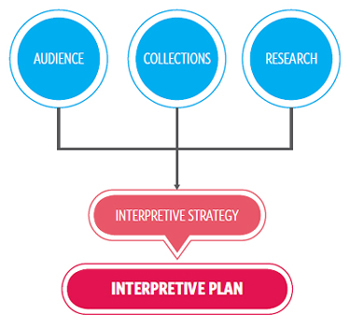|
 If we understand that exhibitions are about meaning, communication and affective
transformation, it follows that they are not
first and foremost a problem of design, but
rather a challenge in planning for effective
communication. Interpretive planning has
emerged as a distinct and respected discipline
in museology and one of the more critical
tasks in the exhibition development process. A
well-structured interpretive plan will not only
provide the foundation for a powerful visitor
experience, but also become a crucial decisionmaking
and organizational tool throughout design and implementation.
If we understand that exhibitions are about meaning, communication and affective
transformation, it follows that they are not
first and foremost a problem of design, but
rather a challenge in planning for effective
communication. Interpretive planning has
emerged as a distinct and respected discipline
in museology and one of the more critical
tasks in the exhibition development process. A
well-structured interpretive plan will not only
provide the foundation for a powerful visitor
experience, but also become a crucial decisionmaking
and organizational tool throughout design and implementation.
What are some the characteristics of a good interpretive plan?
- Visitor-Centred
- Well Researched and Subject-Knowledgeable
- References Best Practices and Trends in Interpretation/Exhibitions
- Budget-Conscious
- Clear Objectives for Learning, Feeling and Doing
- Addresses Collections, Research and Other Resources
- Identifies the Role of Multimedia and Interactivity
- Creative Organizational Structures and Frameworks
|



 If we understand that exhibitions are about meaning, communication and affective
transformation, it follows that they are not
first and foremost a problem of design, but
rather a challenge in planning for effective
communication. Interpretive planning has
emerged as a distinct and respected discipline
in museology and one of the more critical
tasks in the exhibition development process. A
well-structured interpretive plan will not only
provide the foundation for a powerful visitor
experience, but also become a crucial decisionmaking
and organizational tool throughout design and implementation.
If we understand that exhibitions are about meaning, communication and affective
transformation, it follows that they are not
first and foremost a problem of design, but
rather a challenge in planning for effective
communication. Interpretive planning has
emerged as a distinct and respected discipline
in museology and one of the more critical
tasks in the exhibition development process. A
well-structured interpretive plan will not only
provide the foundation for a powerful visitor
experience, but also become a crucial decisionmaking
and organizational tool throughout design and implementation.